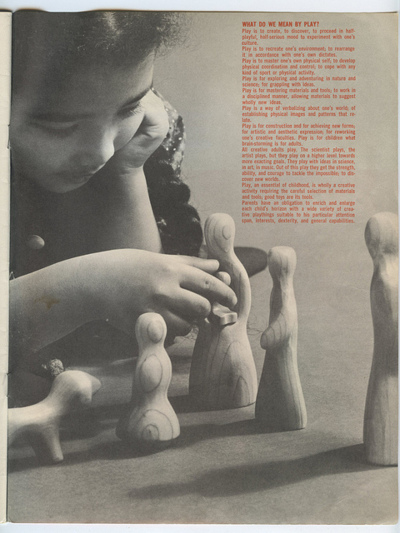
Above is a scan of the “What Do We Mean By Play?” manifesto from 1964’s Creative Playthings, which we think sums up the importance of play pretty well. Here’s a version of that manifesto in a more legible form:
WHAT DO WE MEAN BY PLAY?
Play is to create, to discover, to process in half-playful, half-serious mood to experiment with one’s culture.
Play is to recreate one’s environment; to rearrange it in accordance with one’s own dictates.
Play is to master one’s own physical self; to develop physical coordination and control; to cope with any kind of sport or physical activity.
Play is for exploring and adventuring in nature and science; for grappling with ideas.
Play is for mastering materials and tools; to work in a disciplined manner, allowing materials to suggest wholly new ideas.
Play is a way of verbalizing about one’s world; of establishing physical images and patterns that relate.
Play is for construction and for achieving new forms; for artistic and aesthetic expression; for reworking one’s creative faculties. Play is for children what brain-storming is for adults.
All creative adults play. The scientist plays, the artist plays, but they play on a higher level towards more exacting goals. They play with ideas in science, in art, in music. Out of this play they get the strength, ability, and courage to tackle the impossible; to discover new worlds.
Play, an essential of childhood, is wholly a creative activity requiring the careful selection of materials and tools; good toys are its tools.
Parents have an obligation to enrich and enlarge each child’s horizon with a wide variety of creative playthings suitable to his particular attention span, interests, dexterity, and general capabilities.
Well, this mostly sums it up: we think all this lovely business about play can apply to adults too. Don’t you think?
–Lana Polansky
[via]